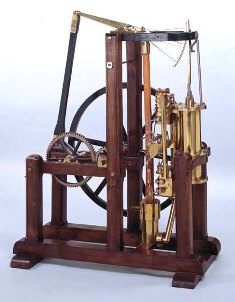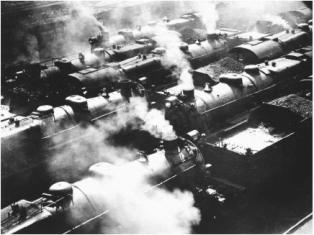The crisis of steam technology
Throughout the XIX century. The improvement of the steam engine continued. Since 1800, when the effect of Watt's patents has ended, the designers of various countries have been particularly active in improving the technical performance of steam power plants with a piston steam engine.
Although the basic structural details of the steam engine and the thermodynamic foundations of its operation remained unchanged, a qualitative change in the steam technology occurred, resulting in an increase in the intensity indices: the steam pressure and superheating, the number of revolutions, specific thermal and force loads, etc., increased.
The use of steam superheating, started back in the 1960s, was particularly widespread in the 1990s. The appearance of high-speed technological machines and engines of vehicles required an increase in the efficiency of steam engines.

Great attention was also paid to steam distribution systems, thanks to which technically advanced devices appeared. This greatly contributed to the development of the American engineer George Corlis. Regulation in its designs was combined with a low steam flow rate and provided the basis for manufacturing high-power machines.
At the Philadelphia exhibition in 1876, Corlis' balancing machine with a capacity of 2500 liters was exhibited. from. And a rotation speed of 36 rpm. However, the steam distribution valves in his machines could not work with the superheated steam, and the balance beam - with a large number of revolutions and therefore could not follow the basic trend of development of steam engines in the last quarter of the 19th century.
Further development of steam piston engines went along the path of creating mpgocylinder designs with multiple expansion of steam; This resulted in an increase in efficiency as a result of using a high pressure drop and a decrease in heat exchange between the steam and the walls of the working cylinders. In the 90's there were machines with two-, three- and four-fold expansion of steam. Thanks to many technical improvements by the end of the XIX century. The thermal efficiency of steam engines has increased 5 times. The steam engine as a universal engine of the large-scale machine industry, transport and, to a certain extent, agriculture (locomobiles) took more and more stable positions up to the 70-80s.
Together with the expansion of the machine mode of production in the second half of the XIX century. The thermal power industry as a whole developed steadily. During this period, quite economical and reliable steam generators were created that met the needs of stationary and transport energy. In the development of boiler industry, there was clearly a tendency to increase steam pressure and increase productivity. Gradually, the most rational design was developed with the division of the gas path and the water volume of the boiler into a large number of small diameter pipes.
As a result, there were two main types of steam generators: gas and water pipes.
Gas tube boilers were most widely recognized in ship, locomotive and locomobile installations, water tube - in stationary installations, including the first thermal power plants. In the 60's and 70's, there were two-chamber water-tube boilers, at the end of the XIX century. - sectional.

Two-chamber boilers, differing only in some details, were manufactured with a pressure of 3-8 at West-European plants.
A typical construction of two-chamber boilers was the Steinmüller boiler, which was produced in Germany. The increase in vapor pressure led to the need to separate the chambers into sections (boilers "Babcock and Wilcox", Shukhov, Belleville, etc.).
Particularly high-quality sectional water-tube boilers were the boilers of the company "Babcock and Wilcox" and the designs of VG Shukhov. Patented in 1896, the boiler of Shukhov, distinguished by its low cost, low metal content and easy transportability, was widely spread in Russia.
By the end of the last century, the appearance of vertical water-tube boilers with straight and curved tubes, which were directly attached to the drum, also applies. A typical example of a stationary vertical boiler is a four-tube boiler constructed by the American Sterling (1894). Thanks to the design that made it possible to arrange three, four, five and six drums, it became widespread. Simultaneously with the Stirling boiler, a multi-drum boiler Garbe (Germany) was used, which also allowed different arrangements of drums.
By the end of the XIX century. In water-tube steam boilers, a relatively high steam capacity was achieved: individual designs allowed to obtain a total heating surface of more than 500 m2 with a total steam capacity of more than 20 t / h.
With the enlargement of industrial enterprises, with the increase in weight and dimensions of the processed materials and semi-finished products, the requirements for the energy base of the industry increased, the energy consumption of individual enterprises increased significantly, and there was an increasing need to attract powerful engines.
Gradually, the growth in the capacity of thermal power plants ceased to be accompanied by a proportional increase in the amount of output produced or a decrease in its prime cost. This circumstance was caused by an increase in unproductive expenses for fuel delivery from the place of its natural location to power plants and increasing losses for transmission and distribution of mechanical energy from the steam engine to machine tools. The main drawback of the steam engine was the difficulty of transferring and "fragmenting" the energy received from it.
Energy was transmitted mainly by transmissions, which ensure the rotational movement of working machines. In the second half of the XIX century. The search for rational designs of all links of transmission devices has intensified; Under the influence of practical inquiries, the theoretical foundations of mechanical transmissions were developed.
Despite improvements in the designs of each of the separate transmission units, the share of power to overcome energy losses has increased, and the overall efficiency has been steadily declining. Since the losses increased sharply with the increase in the amount of transmitted energy and the transmission distances, the power of individual power plants was limited and, as a consequence, the concentration of production became difficult. In the conditions of continuously developing large-scale industry, this was a significant shortcoming of the steam power industry, which led it into a state of crisis.
Another drawback of the steam drive was associated with the impossibility of transition when it was used to the progressive forms of industrial organization, which was urgently required by an ever increasing mechanization of production processes and an increase in the number of machines. In the 1990s, the trend of line production began to be clearly manifested as the most economical form of labor organization in the mass use of machines. The transmission system of mechanical distribution of energy precluded the possibility of establishing stream production. Significantly less frequently used individual drive mechanisms from small steam engines, but this kind of mechanization was hindered by the unprofitability of small heat-power plants.
Disadvantages of the steam drive with mechanical energy distribution hindered the concentration and intensification of industrial production. There were internal combustion engines, but their share in the overall energy balance of the world was not yet palpable. Thus, in the last third of the XIX century. Power engineering experienced a deep crisis, and during this period the electric method of transmission and distribution of mechanical energy began to emerge.
Shukhardin S. V. "Technology in its historical development"


Comments
When commenting on, remember that the content and tone of your message can hurt the feelings of real people, show respect and tolerance to your interlocutors even if you do not share their opinion, your behavior in the conditions of freedom of expression and anonymity provided by the Internet, changes Not only virtual, but also the real world. All comments are hidden from the index, spam is controlled.